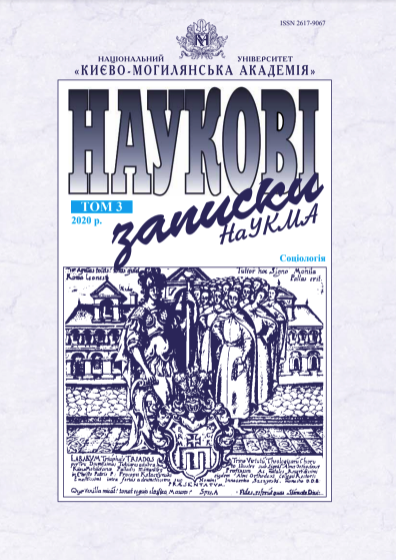Сприйняття посттравматичного стресового розладу в Україні: аналіз диспозитивів сайту новин «Цензор.нет»
DOI:
https://doi.org/10.18523/2617-9067.2020.3.49-57Ключові слова:
посттравматичний стресовий розлад (ПТСР), ветерани, Антитерористична операція (АТО), операція Об’єднаних сил (ООС), стигма, критичний дискурс-аналіз, аналіз диспозитивівАнотація
Незважаючи на існування ефективних методів лікування посттравматичного стресового розладу (ПТСР), багато ветеранів АТО та ООС не звертаються по допомогу через стигму ПТСР, наявну в українському суспільстві. Метод критичного дискурс-аналізу було застосовано для з’ясування того, які дискурси про ПТСР наявні в українських медіа. Було виявлено, що дискурси, поширені серед різних учасників надання допомоги ветеранам, по-різному визначають те, чим прийнято вважати ПТСР у ветеранів АТО та ООС в Україні.
Матеріал надійшов 29.02.2020
Посилання
- American Psychiatric Association. (1995). Diagnostic criteria from DSM-III-R (V. F. Zhmyr, Ed.). Kyiv: Abrys [in Ukrainian].
- American Psychiatric Association. (2013). Diagnostic and Statistical Manual of Mental Disorders (5th ed.). Washington, DC: American Psychiatric Association. https://doi.org/10.1176/appi.books.9780890425596
- Britt, T. W., Greene-Shortridge, T. M., & Castro, С. А. (2007). The Stigma of Mental Health Problems in the Military. Military Medicine, 172, 157–161.
- Burnam, M. A., Meredith, L. S., Helmus, T. C., Burns, R. M., Cox, R. A., D’Amico, E., ... Yochelson, M. R. (2008). Systems of Care: Challenges and Opportunities to Improve Access to High-Quality Care. In T. Tanielian & L. Jaycox (Eds.), Invisible
- Wounds of War: Psychological and Cognitive Injuries, Their Consequences, and Services to Assist Recovery (pp. 245–428). Rand Corporation. http://search.ebscohost.com/login.aspx?direct=true&db=edsgvr&AN=edsgcl.1769900022&site=eds-live
- Caborn, J. (2007). On the Methodology of Dispositive Analysis. Critical Approaches to Discourse Analysis Across Disciplines, 1(1), 112–123. https://www.lancaster.ac.uk/fass/journals/cadaad/wp-content/uploads/2015/01/Volume-1_Caborn.pdf
- Chernenko, I. I., & Сhukhno, I. А. (2017). Modern methods of psychological therapy in patients with post-traumatic stress disorders in terms of their medical and social importance. International Neurological Journal, 5(91), 112–115. https://doi.org/10.22141/2224-0713.5.91.2017.110864
- Corrigan, P. W. (2004). How stigma interferes with mental health care. American Psychologist, 59(7), 614–625. https://doi.org/10.1037/0003-066X.59.7.614
- Corrigan, P. W., & Watson, A. C. (2002). The paradox of self-stigma and mental illness. Clinical Psychology: Science and Practice, 9(1), 35–53. https://doi.org/10.1093/clipsy/9.1.35
- Dickstein, B. D., Vogt, D., Handa, S., & Litz, B. (2010). Targeting self-stigma in returning military personnel and veterans: A review of intervention strategies. Military Psychology, 22(2), 224–236. https://doi.org/10.1080/08995600903417399
- Finley, E. (2011). Embattled: The Politics of PTSD in VA Mental Health Care. In Fields of Combat: Understanding PTSD among Veterans of Iraq and Afghanistan (pp. 113–134). Cornell University Press. doi:10.7591/j.ctt7zbp2.13
- Gould, M., Adler, A. B., Zamorski, M., Castro, C., Hanily, N., Steele, N., ... Greenberg, N. (2010). Do stigma and other perceived barriers to mental health care differ across Armed Forces? Journal of the Royal Society of Medicine, 103(4), 148–156. https://doi.org/10.1258/jrsm.2010.090426
- Gould, M., Greenberg, N., & Hetherton, J. (2007). Stigma and the military: Evaluation of a PTSD psychoeducational program. Journal of Traumatic Stress, 20(4), 505–515. https://doi.org/10.1002/jts.20233
- Hooyer, K. (2012). Going AWOL: Alternative Responses to PTSD Stigma in the U.S. Military. Field Notes: A Journal of Collegiate Anthropology, 4(1), 106–128.
- Jäger, S. (2013). 3 Discourse and knowledge: Theoretical and methodological aspects of a critical discourse and dispositive analysis. In Methods of Critical Discourse Analysis (pp. 32–62). 6 Bonhill Street, London EC2A 4PU: SAGE Publications, Ltd. https://doi.org/10.4135/9780857028020.d5
- Link, B. G., & Phelan, J. C. (2001). Conceptualizing Stigma. Annual Review of Sociology, 27(1), 363–385. https://doi.org/10.1146/ annurev.soc.27.1.363
- Lomat’ kop’ya. (n.d.). Retrieved February 17, 2020, from https://phraseology.academic.ru/6271/Lomat’_kop’ya
- Maier, F., & Jäger, S. (2016). Analysing discourses and dispositives: A Foucauldian approach to theory and methodology (pp. 109–136).
- Mittal, D., Drummond, K. L., Blevins, D., Curran, G., Corrigan, P. W., & Sullivan, G. (2013). Stigma associated with PTSD: Perceptions of treatment seeking combat veterans. Psychiatric Rehabilitation Journal, 36(2), 86–92. https://doi.org/10.1037/h0094976
- Murphy, D., & Busuttil, W. (2015). PTSD, stigma and barriers to help-seeking within the UK Armed Forces. Journal of the Royal Army Medical Corps, 161(4), 322–326. https://doi.org/10.1136/jramc-2014-000344
- Phillips, L., & Jorgensen, M. V. (2008). Discursive Psychology. In L. Phillips & M. V. Jorgensen, Discourse Analysis as Theory and Method (p. 352). Kharkiv: Gumanitarnyj centr [in Russian].
- Pietrzak, R. H., Johnson, D. C., Goldstein, M. B., Malley, J. C., & Southwick, S. M. (2009). Perceived Stigma and Barriers to Mental Health Care Utilization Among OEF-OIF Veterans.
- Psychiatric Services, 60(8), 1118–1122. https://doi.org/10.1176/ps.2009.60.8.1118
- Scott, W. J. (1992). PTSD and Agent Orange: Implications for a Sociology of Veterans’ Issues. Armed Forces & Society, 18(4), 592–612. https://doi.org/10.1177/0095327X9201800409
- TOP-50 Ukrainian online media. (n.d.). https://texty.org.ua/d/2018/media-ranking/list.html
- WHO. (1999). The ICD-10. Classification of Mental and Behavioural Disorders : Clinical descriptions and diagnostic guidelines (L. Finkelshtein, Ed.). Kyiv: Fakt [in Russian].
- Wodak, R., & Meyer, M. (2009). Critical Discourse Analysis: History, Agenda, Theory, and Methodology. In R. Wodak & M. Meyer (Eds.), Methods for Critical Discourse Analysis (2nd revise, pp. 1–33). London: Sage. https://us.corwin.com/sites/default/files/upm-binaries/24615_01_Wodak_Ch_01.pdf
- Zavorotnyi, V. I. (2017). Post-traumatic stress disorders in participants of the anti-terrorist operation (combat psychogenias, clinical-psychopathological characteristics). Ukrainskyi Visnyk Psykhonevrolohii, 1(90), 48–50 [in Russian].
##submission.downloads##
Як цитувати
Номер
Розділ
Ліцензія
Авторське право (c) 2020 Roman Basii

Ця робота ліцензується відповідно до Creative Commons Attribution 4.0 International License.
Автори, які публікуються у цьому журналі, погоджуються з такими умовами:
а) Автори зберігають за собою авторські права на твір на умовах ліцензії Creative Commons Attribution License CC BY 4.0, котра дозволяє іншим особам вільно поширювати (копіювати і розповсюджувати матеріал у будь-якому вигляді чи форматі) та змінювати (міксувати, трансформувати, і брати матеріал за основу для будь-яких цілей, навіть комерційних) опублікований твір на умовах зазначення авторства.
б) Журнал дозволяє автору (авторам) зберігати авторські права без обмежень.
в) Автори мають право укладати самостійні додаткові угоди щодо поширення твору (наприклад, розміщувати роботу в електронному репозитарії), за умови збереження посилання на його першу публікацію. (Див. Політика Самоархівування)
г) Політика журналу дозволяє розміщення авторами в мережі Інтернет (наприклад, у репозитаріях) тексту статті, як до подання його до редакції, так і під час його редакційного опрацювання, оскільки це сприяє виникненню продуктивної наукової дискусії та позитивно позначається на оперативності та динаміці цитування опублікованої роботи (див. The Effect of Open Access).



